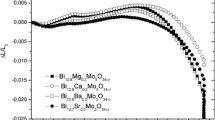Samples of the solid solutions Zr0.9Y0.1O2–δ–BiScO3 and Ce0.9Y0.1O2–δ–BiScO3 were obtained by solid-phase synthesis. X-ray diffraction revealed that the system Zr0.9Y0.1O2–δ–BiScO3 corresponds to a tetragonal structure with space symmetry group P42/nmc. The ceramic Ce0.9Y0.1O2–δ–BiScO3 is two-phase and is characterized by a cubic structure with space symmetry group \(Fm\overline{3 }m\) and Ia–3. It was ascertained by means of impedance spectroscopy that the system Ce0.9Y0.1O2–δ–BiScO3 has the highest electrical conductivity, but the activation energy is lower in the ceramic Zr0.9Y0.1O2-δ–BiScO3, equal to 0.3 eV in the temperature range 420 – 680°C. The activation energy of the solid solution Ce0.9Y0.1O2–δ–BiScO3 is equal to 1.0 eV.




Similar content being viewed by others
References
J. Zhang, Ch. Lenser, N. H. Menzler, and O. Guillon, “Comparison of solid oxide fuel cell (SOFC) electrolyte materials for operation at 500°C,” Solid State Ionics, 344, 115 – 138 (2020).
S. Dwivedi, “Solid oxide fuel cell: Materials for anode, cathode and electrolyte,” Int. J. Hydrogen Energy, 45, 23988 – 24013 (2020).
E. L. Brosha, R. Mukundan, D. R. Brown, et al., “Development of ceramic mixed potential sensors for automotive applications,” Solid State Ionics, 148, 61 – 69 (2002).
B. Singh, S. Ghosh, S. Aich, and B. Roy, “Low temperature solid oxide electrolytes (LT-SOE): Areview,” J. Power Sources, 339, 103 – 135 (2017).
D. W. Strickler and W. G. Carlson, “Ionic conductivity of cubic solid solutions in the system CaO–Y2O3–ZrO2,” J. Am. Ceram. Soc., 47, 122 – 127 (1964).
J. H. Lee, S. M. Yoon, B. K. Kim, et al., “Electrical conductivity and defect structure of yttria-doped ceria-stabilized zirconia,” Solid State Ionics, 144, 175 – 184 (2001).
H. Inaba and H. Tagawa, “Review Ceria-based solid electrolytes,” Solid State Ionics, 83, 1 – 16 (1996). URL: https://doi.org/10.1016/0167-2738(95)00229-4
J. Kang, W. Feng, D. Guo, et al., “Performance optimization of Ca and Y co-doped CeO2-based electrolyte for intermediate-temperature solid oxide fuel cells,” J. Alloys Comp., 913, 165 – 317 (2022). URL: https://doi.org/10.1016/j.jallcom.2022.165317
L. S. Mahmud, A. Muchtar, and M. R. Somalu, “Challenges in fabricating planar solid oxide fuel cells: A review,” Renewable and Sustainable Energy Rev., 72, 105 – 116 (2017). URL: https://doi.org/10.1016/j.rser.2017.01.019
M. Irshad, K. Siraj, R. Raza, et al., “Description of high temperature solid oxide fuel cell’s operation, materials, design, fabrication technologies and performance,” Appl. Sci., 6(3), 75 (2016). URL: https://doi.org/10.3390/app6030075
H. Shi, C. Su, R. Ran, et al., “Review. Electrolyte materials for intermediate-temperature solid oxide fuel cells,” Progr. Natural Sci.: Mater. Int., 30(6), 764 – 774 (2020). URL: https://doi.org/10.1016/j.pnsc.2020.09.003
S. Lubke and H. D. Wiemhofer, “Electronic conductivity of Gd-doped ceria with additional Pr-doping,” Solid State Ion., 117, 229 – 243 (1999). URL: https://doi.org/10.1016/S0167-2738(98)00408-1
P. Shu, H.-D.Wiemhöfer, U. Guth, et al., “Oxide ion conducting solid electrolytes based on Bi2O3,” Solid State Ionics, 89, 179 – 196 (1996). URL: https://doi.org/10.1016/0167-2738(96)00348-7
D. W. Joh, J. H. Park, D. Kim, et al., “Functionally graded bismuth oxide/zirconia bilayer electrolytes for high-performance intermediate-temperature solid oxide fuel cells (IT-SOFCs),” ACS Appl. Mater. Interfaces, 9, 8443 – 8449 (2017). https://doi.org/10.1021/acsami.6b16660
D. W. Joh, J. H. Park, D. Y. Kim, et al., “High performance zirconia-bismuth oxide nanocomposite electrolytes for low temperature solid oxide fuel cells,” J. Power Sources, 320, 267 – 273 (2016).
L. Miao, J. Hou, K. Dong, and W. Liu, “A strategy for improving the sinterability and electrochemical properties of ceria-based LT-SOFCs using bismuth oxide additive,” Int. J. Hydrogen Energy, 44(11), 5447 – 5453 (2019). URL: https://doi.org/10.1016/j.ijhydene.2018.10.223
O. N. Ivanov, I. V. Sudzhanskaya, and M. N. Yapryntsev, “Manufacture, structure, and electric conductivity of ZrO2–SrTiO3–BiScO3 ceramics,” Glass Ceram., 72(11), 413 – 416 (2016). https://doi.org/10.1007/s10717-016-9800-4]
I. V. Sudzhanskaya, M. N. Yaprintsev, Yu. S. Nekrasova, et al. “Effect of BiScO3 additive on the structure and electrical properties of the Y2O3–ZrO2–SrTiO3 system,” J. Nano- and Electronic Phys., 11(1), 01018 – 01022 (2019). https://doi.org/10.21272/jnep.11(1).01018
V. V. Deshmukh, C. R. Ravikumar, M. R. Anil Kumar, et al. “Structure, morphology, and electrochemical properties of SrTiO3 Perovskite: Photocatalytic and supercapacitor applications,” Envir. Chem. Ecotoxic., 3, 241 – 248 (2021). URL: https://doi.org/10.1016/j.enceco.2021.07.001
R. D. Shannon, “Revised effective ionic radii and systematic studies of interatomic distances in halides and chaleogenides,” Acta Cryst., A32, 751 (1976).
B. Singh, S. Ghosh, S. Aich, and B. Roy, “Low temperature solid oxide electrolytes (LT-SOE): Areview,” J. Power Sources, 339, 103 – 135 (2017).
T.-H. Yeh and C.-C. Chou, “Ionic conductivity investigation in samarium and strontium co-doped ceria system,” Phys. Scr., 129, 303 – 307 (2007). URL: https://doi.org/10.1088/0031-8949/2007/T129/067
Author information
Authors and Affiliations
Corresponding author
Additional information
Translated from Steklo i Keramika, No. 6, pp. 54 – 59, June, 2023.
Rights and permissions
Springer Nature or its licensor (e.g. a society or other partner) holds exclusive rights to this article under a publishing agreement with the author(s) or other rightsholder(s); author self-archiving of the accepted manuscript version of this article is solely governed by the terms of such publishing agreement and applicable law.
About this article
Cite this article
Sudzhanskaya, I.V., Sotnikova, V.S. M0.9Y0.1O2–δ–BiScO3 (M = Zr, Ce) — Preparation, Structure, and Ionic Conductivity. Glass Ceram 80, 250–253 (2023). https://doi.org/10.1007/s10717-023-00592-8
Received:
Published:
Issue Date:
DOI: https://doi.org/10.1007/s10717-023-00592-8




